frhrwa
New member
Passive Low-Level Networks
Line-Level Adapter
Suppose you want to add a new amplifier and speakers to your car's factory sound system. Finding a place to mount the amp is easy, as is dropping in the new speakers, but connecting the amp to the factory head unit isn't that simple.
The problem is that most amps accept only low-level "line" inputs and virtually all factory heads use high-level "speaker" outputs, which are incompatible. The fix is to wire in a line-level adapter, or line-out converter, which makes them compatible. (The same fix is required if you are connecting a component amplifier to a store-bought head that doesn't have line-level outputs.)
This simple circuit consists of two resistors, which reduce the high-level output voltage of the head unit to the appropriate level. LLA's are sold for $12 to $15 by accessory companies like American International (805- 388-7900), Ampersand (818-998- 9201), and Scosche (805-523-0687). Building your own adapter is simply a matter of inserting resistors of the proper value in the signal path.
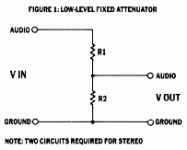
If you're up to the task of assembling one, you have to work with the following four equations, which are used to determine the values of the resistors and the degree of attenuation they'll introduce.
(Note that Vin stands for input voltage in volts, Vout for output voltage in volts, and R for resistance in Ohms.)
Equation 1
Ratio (Output Voltage to Input Voltage) = Vout / Vin
Equation 2
R2 = (Ratio x Rl) / ( 1 – Ratio)
Equation 3
dB = 20 x LOG (Ratio)
Equation 4
Vout = Vin x [R2 / (Rl + R2)]
Since the output voltage of a typical factory head unit is 10 volts, it must be reduced by a factor of 10 to step it down to 1 volt, which is the maximum input voltage accepted by the majority of component amplifiers. Therefore, we can use an output-to-input ratio of 1/10, or 0.1, as a starting point.
Next, we must select a value for Rl, which should be equal to the amp's input impedance (consult the amp's spec sheet for this figure). Since the impedance of most amps is 10,000 ohms, we'll use a standard 10,000-ohm (10-KOhm) value for Rl.
Complete the second equation by substituting 10,000 for R1 and 0.1 for Ratio:
R2 = (0.1 x 10,000) / (1 – 0.1)
R2 = 1,000 / 0.9
R2 = 1,111 ohms
Now that we know the optimal value of R2 is 1,111, we can select a real-world resistor that's close in value – in this case a 1.2-KOhm resistor will do the trick. (Resistors within 10 or 20 percent of the required value will work fine.) Resistors come in standard values and can be purchased from Radio Junk or other electrical-component outlets; you can buy two for less than 50 cents.
The third equation (a standard text-book formula) is used to determine how much attenuation (in dB) the circuit will provide. First, plug in the Ratio (0.1):
dB = 20 x LOG (0.1)
dB = 20 x –1
dB = –20
To work through this equation, you'll need a calculator with a LOG (logarithm) key. (To find the log of 0.1, for example, you simply punch in 0.1 and hit LOG.) The bottom line: A line-level adapter using 10-KOhm and 1.2-KOhm resistors will reduce signal output by 20 dB (the minus sign indicates a voltage drop) when the head unit and amp in use exhibit a 0.1 output/ input ratio.
The fourth equation is used to calculate the output voltage of the line-level adapter. Assuming the head unit's output voltage is 10 volts, the calculation would go as follows:
Vout = 10 x [1,200 / (10,000 + 1,200)]
Vout = 10 x [1,200 / 11,200]
Vout = 10 x 0.1
Vout = 1 (volt)
To assemble the circuit, begin by soldering the two resistors together (see Figure 1). Then solder the positive input lead from the head unit to the open side of the 10-KOhm resistor (Rl) and the negative input lead (ground) to the open side of the 1.2-KOhm resistor (R2). Next, solder the positive output lead running to the amp to the junction where the two resistors meet. Finally, solder the negative lead running to the amplifier to the open side of R2.
Adjustable-Level Control
Instead of reducing signal output by a fixed amount (like a line-level adapter), the adjustable-level control varies signal level via a rotary potentiometer, or "pot." The ALC is commonly used as a remote input-sensitivity control to adjust the output of a single amplifier that doesn't have one built in. The wiring is easy: The pot goes in-line prior to the amplifier's inputs.
Potentiometers are characterized by the number of "gangs" they have; a "single-gang" pot has three connecting terminals for mono use, and a "dual-gang" pot has six for stereo applications. A single-gang design uses one "resistive wafer" (a special type of resistor), while a dual-gang design uses two such elements.
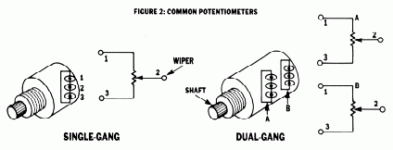
To select the appropriate pot for an adjustable-level control – or any of the other potentiometer-based devices discussed here – you simply match the impedance value of the pot to the input impedance of the amplifier you're using (in most cases 10,000 ohms, or 10 KOhms). In addition, the pot should be of the 0.25-watt (or greater), single-turn, linear-taper variety for best results. Pots can be purchased for $2 to $5 at electrical-component outlets.
The ALC works like this: As the pot's shaft moves, an internal "wiper" changes the ratio of the resistance between Terminals 1 and 2 and Terminals 2 and 3 in Figure 2. Turning the shaft clockwise moves the wiper (Terminal 2) away from the negative terminal (Terminal 3) and closer to the positive terminal (Terminal 1); the closer the wiper is to the positive terminal, the higher the output voltage and the resulting output. Conversely, rotating the shaft counterclockwise moves the wiper toward the negative terminal (Terminal 3) and reduces the output level. When the pot is set to its center position, the wiper is exactly in between the positive and negative terminals and the circuit's output voltage is half the input voltage.
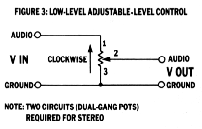
The first step in assembling a single-gang network is to solder the head unit's positive input and negative input (ground) leads to Terminals 1 and 3 on the pot, respectively (Figure 3). Then solder the amp's positive and negative output leads to Terminals 2 and 3, respectively. Once the wiring is completed, you can mount the pot anywhere that's convenient.
Balance Control
Achieving a proper mix between left- and right-channel output usually isn't a problem because most head units have balance controls built in – but there are exceptions, such as a system that uses a portable CD player to deliver source signals. The balance control is built around the "dual-gang" pot described above and is essentially two ALC's – one for each channel – whose polarities are opposite.
As the shaft of the dual-gang pot rotates, the wiper for each gang moves in synchronization. Figure 4 shows that the polarity of the right input terminals, Al and A3, is the reverse of that for the left input terminals, Bl and B3. Therefore, turning the shaft clockwise increases the output level of the right channel while simultaneously decreasing the output level of the left channel; rotating the shaft counterclockwise has the opposite effect. When the shaft is set to its center point, the volume for both channels is the same.
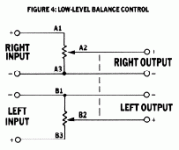
The first step in assembling a balance control is to solder the right and left positive-input leads to the pot's Al and B3 terminals, respectively. Then solder the right negative-input lead to Terminal A3 and the left negative-input lead to Terminal B 1. Next, solder the right positive-output lead to Terminal A2 and the left positive-output lead to Terminal B2. Finally, solder the right negative-output lead to Terminal A3 and the left negative- output lead to Terminal Bl. Again, you can mount the pot in any convenient location.
Fader
A fader allows you to adjust the balance between front and rear speakers, and it's one of the most useful low-level circuits; fortunately, faders are built into most head units. Still, there are some heads out there that don't have them – older ones and those that came stock in some pickup trucks, for example.
The fader has inputs for left and right audio signals, and from each of those inputs it creates front and rear stereo outputs using a four-gang pot, which resembles two dual-gang pots and has twelve terminals. Note in Figure 5 that each audio signal (designated as L+, L-, R+, and R- ) is connected to separate gangs (each gang has three terminals). The circuit operates in similar fashion to the ALC, although it's more complex: Rotating the pot's shaft clockwise increases rear-channel output while simultaneously decreasing front-channel output; rotating it counterclockwise reverses the effect.
To assemble a fader, you solder the left positive-input lead to Terminals Al and B3 and the right positive-input lead to Terminals C1 and D3 (Figure 5). Then solder the left negative-input lead (ground) to Terminals A3 and Bl and the right negative-input lead to Terminals C3 and Dl. Next, solder the following connections: the front-left positive-output lead to Terminal A2, the rear-left positive-output lead to Terminal B2, the front-right positive lead to Terminal C2, and the rear-right positive-output to Terminal D2. Finally, solder the left front/rear negative-output leads to Terminals A3 and Bl and the right front/rear negative-output leads to Terminals C3 and Dl. Once assembled, the fader control can be mounted in an enclosure or control panel.
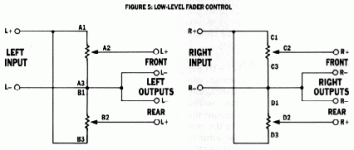
Note that many head units that feature built-in amplifiers and RCA line-level outputs have what is called a "bi-level" fader. Bi-level means that the fader controls both the speaker-level outputs and the RCA line-level outputs. In a typical four-speaker system, the head unit's built-in amplifiers could be used to power the front pair of speakers, while an outboard amp could be used to drive the rear pair of speakers. Some four-channel head units can only fade between their internal amps, however, so if you want to add an external amplifier, you have to wire in an outboard fader between the two components. And if you're using an unpowered head unit and a four-channel outboard amp, you'll need to run the head's front and rear outputs into an outboard fader and then on to the amplifier.
Dual-Amp Balancer
Think of this circuit as a convenience – a way to bring all of the input-sensitivity controls in a multi-amp system to your fingertips. Actually, the dual-amp balancer is two ALC's in one box, and it splits a common input signal into two variable outputs. Say your system has two woofers, each of which has a dedicated amplifier, and you want to balance the output between the two – but the amps are tucked away behind a panel in the trunk. You can either run around to the rear of the vehicle to make an adjustment, or you can install a dual-amp balancer in-line between the dedicated crossovers' low-pass output and the amplifier's inputs. Although balancing the output of amplifiers is usually a one-time affair, some people like being able to control bass output on a whim. With the balancer, it's simply a matter of rotating a conveniently located pot.
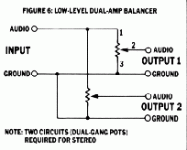
Figure 6 depicts a typical dual-amp-balancer circuit. Note that the audio signal is connected to one side of each of two individual pots and that the output of each pot is controlled by rotating its respective shaft. Dual-amp balancers are available for $40 and up from Clarion, Nakamichi, Orion, and other companies, or you can build your own following the schematic in Figure 6. First, solder the positive-input lead to Terminal 1 of both potentiometers. Then solder the negative-input leads to Terminal 3 of both pots. Finally, solder the positive lead of Output 1 to Terminal 2 on the first pot and the positive lead of Output 2 to Terminal 2 on the second pot; the negative-output leads attach to the Terminal 3 on each pot.
Active Low-Level Networks
In contrast to passive devices, active networks are relatively complex, powered devices that allow you to cut and boost the amplitude of a low-level signal; due to their complexity, construction details are not provided.
Active Line Driver
This popular circuit offers solutions to just about any line-level matching problem you're likely to encounter. For example, suppose your head unit's output voltage is 50 millivolts but the amplifier you want to use requires an input signal of 250 millivolts or more for optimum performance. To use this amp, you'd have to step up the head unit's output voltage by inserting an ALD between the head unit's output and the amp's inputs. The only other option – which isn't nearly as practical – would be to run the signal through a preamplifier that has a gain control. The ALD is a box that is designed to be hidden away; various line drivers are available for about $30 from David Levy (800-421-3536) and other accessory companies.
Constant-Bass Network
This increasingly popular circuit has found its way into a number of crossovers, including the a/d/s/ 642CSi and Hafler's MAX-410. Constant-bass circuitry provides subwoofer outputs that are independent of the fader control; bass output remains constant despite the position of the head unit's fader control, and adjusting the fader affects only mid and high frequencies. The idea is that you won't lose your system's low end when you fade forward to strengthen the front image.
High-Level Networks
Power-Dropping Network
A PDN is a simple circuit, involving nothing more than a high-power resistor that's been inserted in-line with the positive speaker lead; its effect is to reduce the power going to that speaker. The amount of power that's "soaked up" by the resistor is determined by the value of the resistor used and the impedance of the speaker. While the use of a PDN isn't very efficient, it's the simplest way of balancing frequency output in a system that employs one amplifier to power woofers, midranges, and tweeters.
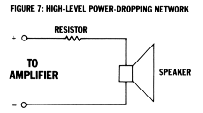
To design a PDN, consider the following four equations, in which Pin stands for power input (in watts), Pout for power output (in watts), Pres for power dissipated in the resistor, Z for speaker impedance (in ohms), and R for resistor value (in ohms).
Equation 5
Ratio (Power Output to Power Input) = Pout / Pin
Equation 6
R = (Z / Ratio) – Z
Equation 7
Pres = Pin x [R / (R + Z)]
Equation 8
dB = 10 x LOG (Ratio)
Say the problem is that the midranges in a three-way system are too dominant. As a starting point, we can assume that halving the power sent to them will do the trick, which means an output/input ratio of 1/2, or 0.5. Assuming the speaker's impedance is the usual 4 ohms, we can determine the correct resistor value by substituting 0.5 for Ratio and 4 for Z in equation 6:
R = (4 / 0.5) – 4
R = 8 – 4
R = 4 ohms
Now we know that both R and Z equal 4. Assuming the amplifier powering this system is rated at 50 watts x 2 continuous, we can determine the necessary power rating of the resistor (how much power will be dissipated in it) by plugging the Pin (50), R (4), and Z (4) values into equation 7 as follows:
Pres = Pin x [R / (R + Z)]
Pres = 50 x [4 / (4 + 4)]
Pres = 50 x [4 / 8]
Pres = 50 x 0.5
Pres = 25 Watts
The result: To halve power going to the midranges you'll need to wire in a 4-ohm resistor that's rated to handle 25 watts. (As a rule, the power rating of the resistor need not be greater than the power-handling capacity of the driver.) The key point to remember is that the resistor must be inserted prior to the passive crossover (if one is in use); this will prevent the PDN from altering the crossover frequency.
To determine how many dB the resistor will cut from the mids' output, substitute 0.5 for the output/input ratio in equation 8:
dB = 10 x LOG (Ratio)
dB = 10 x LOG (0.5)
dB = 10 x ( – 0.3)
dB = – 3
In this example, midrange output would be 3 dB less than that of the woofers and tweeters.
Wiring the PDN in line with the speaker is simple: You solder the positive speaker lead from the amplifier to one side of the resistor (Figure 7). Then you solder a wire from the other side of the resistor to the speaker's positive terminal. Finally, you solder the negative lead from the amplifier to the negative speaker terminal.
Adjustable Shelving Network
This circuit provides the most flexible means of adjusting the amount of wattage delivered to a speaker: You simply rotate a dial to increase and decrease power. Unlike a power-dropping network, it can be inserted between a passive crossover and the speaker, since it presents a constant input impedance. The device that makes this possible is known as an "L-pad" (Figure 8). Although an L-pad looks like a large pot, its internal architecture is very different; essentially, it's a high-power resistive element. L-pads can typically handle between 20 and 50 watts (compared to a lowly 0.25 watt for a pot), and they can be purchased at Radio Junk for between $10 and $25, depending on the amount of power they can handle.
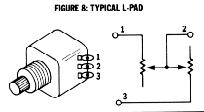
The problem: Your tweeters are mounted in the dash and your midranges are installed well below ear level in the kick panels; a combination of the tweeters' bright quality and their proximity to your ears gives the system a harsh edge. You could move the tweeters to the doors, but that would be a royal pain. A much quicker solution would be simply to drop an L-pad in the positive speaker lead that runs between the high-pass output of the crossover and the tweeter.
The procedure is simple: First you solder the positive lead running from the high-pass crossover to Terminal 3 of the L-pad (Figure 9). Then you solder the negative lead to Terminal 1 of the L-pad and the speaker's negative terminal. Finally, you solder the positive speaker lead to Terminal 2 on the L-pad. Adjusting tweeter output is now a matter of simply rotating the L-pad's shaft.
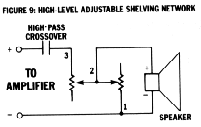
Knowing how to adjust levels will help you to do a better job of mating components and balancing system output – whether you need to tame a certain frequency band or want to cut back on rear fill. And these tricks can squeeze some extra performance out of your system. After all, it's often such attention to detail that transforms a good system into one that is truly outstanding.
Line-Level Adapter
Suppose you want to add a new amplifier and speakers to your car's factory sound system. Finding a place to mount the amp is easy, as is dropping in the new speakers, but connecting the amp to the factory head unit isn't that simple.
The problem is that most amps accept only low-level "line" inputs and virtually all factory heads use high-level "speaker" outputs, which are incompatible. The fix is to wire in a line-level adapter, or line-out converter, which makes them compatible. (The same fix is required if you are connecting a component amplifier to a store-bought head that doesn't have line-level outputs.)
This simple circuit consists of two resistors, which reduce the high-level output voltage of the head unit to the appropriate level. LLA's are sold for $12 to $15 by accessory companies like American International (805- 388-7900), Ampersand (818-998- 9201), and Scosche (805-523-0687). Building your own adapter is simply a matter of inserting resistors of the proper value in the signal path.

If you're up to the task of assembling one, you have to work with the following four equations, which are used to determine the values of the resistors and the degree of attenuation they'll introduce.
(Note that Vin stands for input voltage in volts, Vout for output voltage in volts, and R for resistance in Ohms.)
Equation 1
Ratio (Output Voltage to Input Voltage) = Vout / Vin
Equation 2
R2 = (Ratio x Rl) / ( 1 – Ratio)
Equation 3
dB = 20 x LOG (Ratio)
Equation 4
Vout = Vin x [R2 / (Rl + R2)]
Since the output voltage of a typical factory head unit is 10 volts, it must be reduced by a factor of 10 to step it down to 1 volt, which is the maximum input voltage accepted by the majority of component amplifiers. Therefore, we can use an output-to-input ratio of 1/10, or 0.1, as a starting point.
Next, we must select a value for Rl, which should be equal to the amp's input impedance (consult the amp's spec sheet for this figure). Since the impedance of most amps is 10,000 ohms, we'll use a standard 10,000-ohm (10-KOhm) value for Rl.
Complete the second equation by substituting 10,000 for R1 and 0.1 for Ratio:
R2 = (0.1 x 10,000) / (1 – 0.1)
R2 = 1,000 / 0.9
R2 = 1,111 ohms
Now that we know the optimal value of R2 is 1,111, we can select a real-world resistor that's close in value – in this case a 1.2-KOhm resistor will do the trick. (Resistors within 10 or 20 percent of the required value will work fine.) Resistors come in standard values and can be purchased from Radio Junk or other electrical-component outlets; you can buy two for less than 50 cents.
The third equation (a standard text-book formula) is used to determine how much attenuation (in dB) the circuit will provide. First, plug in the Ratio (0.1):
dB = 20 x LOG (0.1)
dB = 20 x –1
dB = –20
To work through this equation, you'll need a calculator with a LOG (logarithm) key. (To find the log of 0.1, for example, you simply punch in 0.1 and hit LOG.) The bottom line: A line-level adapter using 10-KOhm and 1.2-KOhm resistors will reduce signal output by 20 dB (the minus sign indicates a voltage drop) when the head unit and amp in use exhibit a 0.1 output/ input ratio.
The fourth equation is used to calculate the output voltage of the line-level adapter. Assuming the head unit's output voltage is 10 volts, the calculation would go as follows:
Vout = 10 x [1,200 / (10,000 + 1,200)]
Vout = 10 x [1,200 / 11,200]
Vout = 10 x 0.1
Vout = 1 (volt)
To assemble the circuit, begin by soldering the two resistors together (see Figure 1). Then solder the positive input lead from the head unit to the open side of the 10-KOhm resistor (Rl) and the negative input lead (ground) to the open side of the 1.2-KOhm resistor (R2). Next, solder the positive output lead running to the amp to the junction where the two resistors meet. Finally, solder the negative lead running to the amplifier to the open side of R2.
Adjustable-Level Control
Instead of reducing signal output by a fixed amount (like a line-level adapter), the adjustable-level control varies signal level via a rotary potentiometer, or "pot." The ALC is commonly used as a remote input-sensitivity control to adjust the output of a single amplifier that doesn't have one built in. The wiring is easy: The pot goes in-line prior to the amplifier's inputs.
Potentiometers are characterized by the number of "gangs" they have; a "single-gang" pot has three connecting terminals for mono use, and a "dual-gang" pot has six for stereo applications. A single-gang design uses one "resistive wafer" (a special type of resistor), while a dual-gang design uses two such elements.

To select the appropriate pot for an adjustable-level control – or any of the other potentiometer-based devices discussed here – you simply match the impedance value of the pot to the input impedance of the amplifier you're using (in most cases 10,000 ohms, or 10 KOhms). In addition, the pot should be of the 0.25-watt (or greater), single-turn, linear-taper variety for best results. Pots can be purchased for $2 to $5 at electrical-component outlets.
The ALC works like this: As the pot's shaft moves, an internal "wiper" changes the ratio of the resistance between Terminals 1 and 2 and Terminals 2 and 3 in Figure 2. Turning the shaft clockwise moves the wiper (Terminal 2) away from the negative terminal (Terminal 3) and closer to the positive terminal (Terminal 1); the closer the wiper is to the positive terminal, the higher the output voltage and the resulting output. Conversely, rotating the shaft counterclockwise moves the wiper toward the negative terminal (Terminal 3) and reduces the output level. When the pot is set to its center position, the wiper is exactly in between the positive and negative terminals and the circuit's output voltage is half the input voltage.

The first step in assembling a single-gang network is to solder the head unit's positive input and negative input (ground) leads to Terminals 1 and 3 on the pot, respectively (Figure 3). Then solder the amp's positive and negative output leads to Terminals 2 and 3, respectively. Once the wiring is completed, you can mount the pot anywhere that's convenient.
Balance Control
Achieving a proper mix between left- and right-channel output usually isn't a problem because most head units have balance controls built in – but there are exceptions, such as a system that uses a portable CD player to deliver source signals. The balance control is built around the "dual-gang" pot described above and is essentially two ALC's – one for each channel – whose polarities are opposite.
As the shaft of the dual-gang pot rotates, the wiper for each gang moves in synchronization. Figure 4 shows that the polarity of the right input terminals, Al and A3, is the reverse of that for the left input terminals, Bl and B3. Therefore, turning the shaft clockwise increases the output level of the right channel while simultaneously decreasing the output level of the left channel; rotating the shaft counterclockwise has the opposite effect. When the shaft is set to its center point, the volume for both channels is the same.

The first step in assembling a balance control is to solder the right and left positive-input leads to the pot's Al and B3 terminals, respectively. Then solder the right negative-input lead to Terminal A3 and the left negative-input lead to Terminal B 1. Next, solder the right positive-output lead to Terminal A2 and the left positive-output lead to Terminal B2. Finally, solder the right negative-output lead to Terminal A3 and the left negative- output lead to Terminal Bl. Again, you can mount the pot in any convenient location.
Fader
A fader allows you to adjust the balance between front and rear speakers, and it's one of the most useful low-level circuits; fortunately, faders are built into most head units. Still, there are some heads out there that don't have them – older ones and those that came stock in some pickup trucks, for example.
The fader has inputs for left and right audio signals, and from each of those inputs it creates front and rear stereo outputs using a four-gang pot, which resembles two dual-gang pots and has twelve terminals. Note in Figure 5 that each audio signal (designated as L+, L-, R+, and R- ) is connected to separate gangs (each gang has three terminals). The circuit operates in similar fashion to the ALC, although it's more complex: Rotating the pot's shaft clockwise increases rear-channel output while simultaneously decreasing front-channel output; rotating it counterclockwise reverses the effect.
To assemble a fader, you solder the left positive-input lead to Terminals Al and B3 and the right positive-input lead to Terminals C1 and D3 (Figure 5). Then solder the left negative-input lead (ground) to Terminals A3 and Bl and the right negative-input lead to Terminals C3 and Dl. Next, solder the following connections: the front-left positive-output lead to Terminal A2, the rear-left positive-output lead to Terminal B2, the front-right positive lead to Terminal C2, and the rear-right positive-output to Terminal D2. Finally, solder the left front/rear negative-output leads to Terminals A3 and Bl and the right front/rear negative-output leads to Terminals C3 and Dl. Once assembled, the fader control can be mounted in an enclosure or control panel.

Note that many head units that feature built-in amplifiers and RCA line-level outputs have what is called a "bi-level" fader. Bi-level means that the fader controls both the speaker-level outputs and the RCA line-level outputs. In a typical four-speaker system, the head unit's built-in amplifiers could be used to power the front pair of speakers, while an outboard amp could be used to drive the rear pair of speakers. Some four-channel head units can only fade between their internal amps, however, so if you want to add an external amplifier, you have to wire in an outboard fader between the two components. And if you're using an unpowered head unit and a four-channel outboard amp, you'll need to run the head's front and rear outputs into an outboard fader and then on to the amplifier.
Dual-Amp Balancer
Think of this circuit as a convenience – a way to bring all of the input-sensitivity controls in a multi-amp system to your fingertips. Actually, the dual-amp balancer is two ALC's in one box, and it splits a common input signal into two variable outputs. Say your system has two woofers, each of which has a dedicated amplifier, and you want to balance the output between the two – but the amps are tucked away behind a panel in the trunk. You can either run around to the rear of the vehicle to make an adjustment, or you can install a dual-amp balancer in-line between the dedicated crossovers' low-pass output and the amplifier's inputs. Although balancing the output of amplifiers is usually a one-time affair, some people like being able to control bass output on a whim. With the balancer, it's simply a matter of rotating a conveniently located pot.

Figure 6 depicts a typical dual-amp-balancer circuit. Note that the audio signal is connected to one side of each of two individual pots and that the output of each pot is controlled by rotating its respective shaft. Dual-amp balancers are available for $40 and up from Clarion, Nakamichi, Orion, and other companies, or you can build your own following the schematic in Figure 6. First, solder the positive-input lead to Terminal 1 of both potentiometers. Then solder the negative-input leads to Terminal 3 of both pots. Finally, solder the positive lead of Output 1 to Terminal 2 on the first pot and the positive lead of Output 2 to Terminal 2 on the second pot; the negative-output leads attach to the Terminal 3 on each pot.
Active Low-Level Networks
In contrast to passive devices, active networks are relatively complex, powered devices that allow you to cut and boost the amplitude of a low-level signal; due to their complexity, construction details are not provided.
Active Line Driver
This popular circuit offers solutions to just about any line-level matching problem you're likely to encounter. For example, suppose your head unit's output voltage is 50 millivolts but the amplifier you want to use requires an input signal of 250 millivolts or more for optimum performance. To use this amp, you'd have to step up the head unit's output voltage by inserting an ALD between the head unit's output and the amp's inputs. The only other option – which isn't nearly as practical – would be to run the signal through a preamplifier that has a gain control. The ALD is a box that is designed to be hidden away; various line drivers are available for about $30 from David Levy (800-421-3536) and other accessory companies.
Constant-Bass Network
This increasingly popular circuit has found its way into a number of crossovers, including the a/d/s/ 642CSi and Hafler's MAX-410. Constant-bass circuitry provides subwoofer outputs that are independent of the fader control; bass output remains constant despite the position of the head unit's fader control, and adjusting the fader affects only mid and high frequencies. The idea is that you won't lose your system's low end when you fade forward to strengthen the front image.
High-Level Networks
Power-Dropping Network
A PDN is a simple circuit, involving nothing more than a high-power resistor that's been inserted in-line with the positive speaker lead; its effect is to reduce the power going to that speaker. The amount of power that's "soaked up" by the resistor is determined by the value of the resistor used and the impedance of the speaker. While the use of a PDN isn't very efficient, it's the simplest way of balancing frequency output in a system that employs one amplifier to power woofers, midranges, and tweeters.

To design a PDN, consider the following four equations, in which Pin stands for power input (in watts), Pout for power output (in watts), Pres for power dissipated in the resistor, Z for speaker impedance (in ohms), and R for resistor value (in ohms).
Equation 5
Ratio (Power Output to Power Input) = Pout / Pin
Equation 6
R = (Z / Ratio) – Z
Equation 7
Pres = Pin x [R / (R + Z)]
Equation 8
dB = 10 x LOG (Ratio)
Say the problem is that the midranges in a three-way system are too dominant. As a starting point, we can assume that halving the power sent to them will do the trick, which means an output/input ratio of 1/2, or 0.5. Assuming the speaker's impedance is the usual 4 ohms, we can determine the correct resistor value by substituting 0.5 for Ratio and 4 for Z in equation 6:
R = (4 / 0.5) – 4
R = 8 – 4
R = 4 ohms
Now we know that both R and Z equal 4. Assuming the amplifier powering this system is rated at 50 watts x 2 continuous, we can determine the necessary power rating of the resistor (how much power will be dissipated in it) by plugging the Pin (50), R (4), and Z (4) values into equation 7 as follows:
Pres = Pin x [R / (R + Z)]
Pres = 50 x [4 / (4 + 4)]
Pres = 50 x [4 / 8]
Pres = 50 x 0.5
Pres = 25 Watts
The result: To halve power going to the midranges you'll need to wire in a 4-ohm resistor that's rated to handle 25 watts. (As a rule, the power rating of the resistor need not be greater than the power-handling capacity of the driver.) The key point to remember is that the resistor must be inserted prior to the passive crossover (if one is in use); this will prevent the PDN from altering the crossover frequency.
To determine how many dB the resistor will cut from the mids' output, substitute 0.5 for the output/input ratio in equation 8:
dB = 10 x LOG (Ratio)
dB = 10 x LOG (0.5)
dB = 10 x ( – 0.3)
dB = – 3
In this example, midrange output would be 3 dB less than that of the woofers and tweeters.
Wiring the PDN in line with the speaker is simple: You solder the positive speaker lead from the amplifier to one side of the resistor (Figure 7). Then you solder a wire from the other side of the resistor to the speaker's positive terminal. Finally, you solder the negative lead from the amplifier to the negative speaker terminal.
Adjustable Shelving Network
This circuit provides the most flexible means of adjusting the amount of wattage delivered to a speaker: You simply rotate a dial to increase and decrease power. Unlike a power-dropping network, it can be inserted between a passive crossover and the speaker, since it presents a constant input impedance. The device that makes this possible is known as an "L-pad" (Figure 8). Although an L-pad looks like a large pot, its internal architecture is very different; essentially, it's a high-power resistive element. L-pads can typically handle between 20 and 50 watts (compared to a lowly 0.25 watt for a pot), and they can be purchased at Radio Junk for between $10 and $25, depending on the amount of power they can handle.

The problem: Your tweeters are mounted in the dash and your midranges are installed well below ear level in the kick panels; a combination of the tweeters' bright quality and their proximity to your ears gives the system a harsh edge. You could move the tweeters to the doors, but that would be a royal pain. A much quicker solution would be simply to drop an L-pad in the positive speaker lead that runs between the high-pass output of the crossover and the tweeter.
The procedure is simple: First you solder the positive lead running from the high-pass crossover to Terminal 3 of the L-pad (Figure 9). Then you solder the negative lead to Terminal 1 of the L-pad and the speaker's negative terminal. Finally, you solder the positive speaker lead to Terminal 2 on the L-pad. Adjusting tweeter output is now a matter of simply rotating the L-pad's shaft.

Knowing how to adjust levels will help you to do a better job of mating components and balancing system output – whether you need to tame a certain frequency band or want to cut back on rear fill. And these tricks can squeeze some extra performance out of your system. After all, it's often such attention to detail that transforms a good system into one that is truly outstanding.
Last edited by a moderator:
